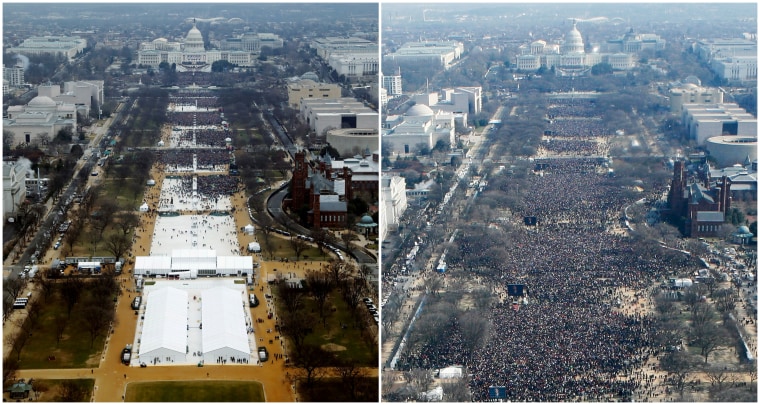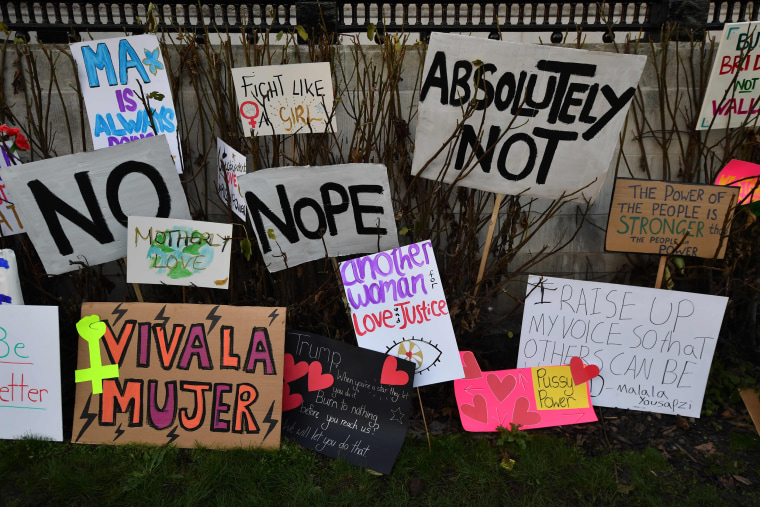President Donald Trump has blasted out controversial executive orders so quickly, it’s been difficult for many to keep up. And some experts say that may be the point.
All presidents work quickly to launch their agendas as they take office. But rarely has one made so many scattershot pronouncements all at once.
“This is definitely bizarre, rapid-fire presidential policy making,” says presidential historian Douglas Brinkley, a professor of history at Rice University. “It really is a ‘shock and awe’ strategy that every day there’s a new, radical initiative, and it doesn’t give journalists or the public a chance to get a grip on what just happened.”
The sheer volume of changes makes last week’s stories surrounding arguments about crowd size or Stephen Bannon’s “shut up” to the media — let alone news about Russian hacking or unsubstantiated allegations of voter fraud — seem old before they're even published, experts on political communication say.
“It’s like firing tons of missiles into the air so that your adversary can’t figure out which missile is real and which isn’t,” says Anthony Pratkanis, a professor of psychology at the University of California Santa Cruz and the author of “Age of Propaganda: The Everyday Use and Abuse of Persuasion.”
“You don’t know which missiles to hit. Is that a decoy, or is that for real? And that allows things that you might not be aware of to sneak through.”
Officials involved in transition planning told the Washington Post that Sen. Jeff Sessions, the attorney general-designate, lobbied for a “shock and awe” approach in the first days of the administration in an attempt to rattle Congress. The military strategy promotes the use of overwhelming speed and disinformation, among other things, to paralyze the opposition.

From that perspective, quibbling over the crowd size at Trump’s inauguration makes sense: Presenting “alternative facts” just adds to the sense of confusion.
“One of the most reliable but chilling findings in psychology is the more that people hear something, the more they think it’s true, even if it isn’t,” says psychologist Carol Tavris, co-author with Elliot Aronson of “Mistakes Were Made (But Not By Me).”
She notes the effectiveness of repetition in Trump’s years-long “birther” movement intended to delegitimize President Barack Obama. “This was not normal political opposition. This was engulf and devour, if you want a military strategy,” she says.
False statements on the campaign trail capped off by a string of early falsehoods from the Trump Administration helped reintroduce the term “gaslighting” into the popular culture. It refers to a 1944 film in which a murderous husband deliberately confuses and manipulates his wife by dimming the gas lights in their home and denying it’s happening, until she doubts her own senses. (An essay called "Donald Trump Is Gaslighting America," published by Teen Vogue in December when Trump was still president-elect, went viral.)
Now add speed and quickfire changes that tax the ability of the political opposition, the media and ordinary citizens to keep up to that baseline sense of confusion. Pratkanis said he saw one protester marching with a white board, to update the sign in real time.
Some have accused Trump of deliberate distraction — sending out tweets about, say, Meryl Streep — instead of focusing on the issues.
“It’s like the magician on stage who makes a puff of smoke — your attention is focused on the flash, meanwhile the tiger is taken offstage. That’s the basic kind of strategy,” Pratkanis says.
Still, if shock and awe is the intent, “it’s fair to say the administration is doing a catastrophic job,” says Harlan Ullman, one of the architects of the doctrine.
Ullman, author of the forthcoming book “Anatomy of Failure: Why America Loses Wars It Starts” calls shock and awe a commonly misunderstood concept. As his team imagined it, shock and awe was based on operational brilliance of execution, total or superior knowledge, control of the environment and rapidity.
Instead, he said, shock and awe came to be known as Gen. Tommy Franks applied it in the second Iraq war: “Get to Baghdad, destroy the Iraqi army and get out. The result was catastrophe.”

By Ullman's metric, Trump is failing at all but speed — and even there, he’s facing opposition that has mobilized more quickly than the White House could respond.
Traditionally when a president has moved this quickly, it’s because he has won an overwhelming mandate — think Franklin Delano Roosevelt in 1932 or Ronald Reagan in 1980. In this case, Trump lost the popular vote to Democrat Hillary Clinton by nearly 3 million votes and entered office with a 40 percent approval rating, the lowest of any president, notes the presidential historian Brinkley.
“I think he feels the 100 days of FDR and Ronald Reagan is passe, that in a speeded-up media environment, he wants to be known in history as having his first 100 hours be revolutionary,” he said.
“It’s like the football player who starts throwing Hail Mary passes on the first down," Brinkley added. "It’s exciting and he might make a touchdown or two, but there’s a reason most professional coaches don’t do that. In the long run it’s a good way to lose the game”

